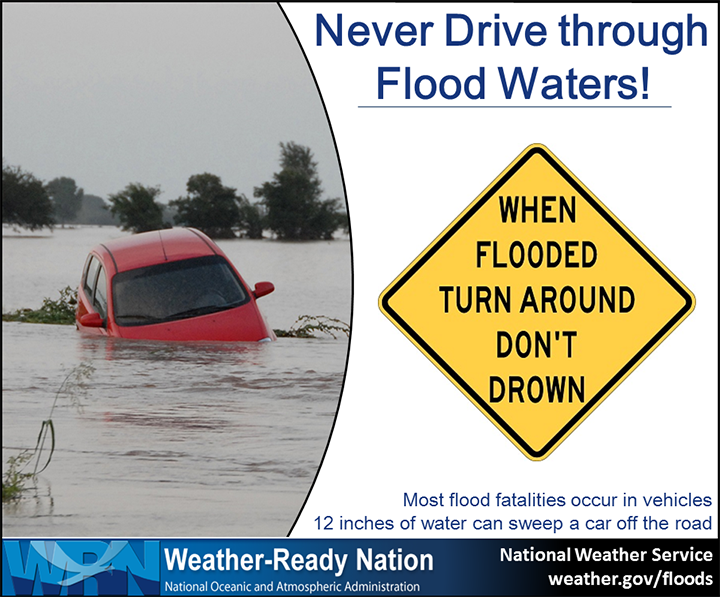Severe Weather Awareness Week Day 5: Flood Safety Tips

Table of Contents
Understanding Flood Risks in Your Area
Before a flood even threatens, understanding your individual risk is paramount. Knowing your vulnerability allows for better planning and quicker responses during an emergency. Different areas face different types of flood risks.
- Floodplain Maps: Familiarize yourself with FEMA's flood maps (fema.gov). These maps identify areas with a high probability of flooding, helping you assess your personal risk. Understanding if your property sits within a designated floodplain is crucial for insurance and preparedness.
- Historical Flood Data: Research past flooding incidents in your region. Local government websites, historical societies, and news archives often contain valuable information about past flood events, including their severity and frequency. This helps gauge the potential scale of future floods.
- Types of Floods: Be aware of the various types of floods that can occur in your area:
- Riverine Floods: These occur when rivers overflow their banks due to heavy rainfall or snowmelt.
- Flash Floods: These are rapid, intense floods that can develop in a matter of minutes, often triggered by intense rainfall in a short period. They pose a particularly high risk.
- Coastal Floods: These are caused by storm surges, high tides, and strong winds associated with hurricanes or other severe weather events.
- Alerts and Warnings: Pay close attention to local weather alerts and warnings issued by the National Weather Service (weather.gov). Understanding the difference between a flood watch (conditions are favorable for flooding) and a flood warning (flooding is imminent or already occurring) is essential for timely action.
Creating a Flood Preparedness Plan
Proactive planning is key to mitigating the impact of a flood. Don't wait until a flood is imminent to start thinking about safety. A well-defined plan can significantly improve your chances of survival and minimize property damage.
- Flood Emergency Kit: Assemble a kit containing essential supplies such as:
- At least one gallon of water per person per day for several days.
- Non-perishable food items.
- First-aid kit and any necessary medications.
- Important documents (identification, insurance policies, medical records) stored in waterproof containers.
- Flashlights, batteries, and a portable radio.
- Family Communication Plan: Establish a clear plan for how family members will communicate during and after a flood, including designated meeting points and contact information for out-of-area relatives or friends.
- Evacuation Routes and Meeting Points: Identify multiple evacuation routes and designate safe meeting points outside of flood-prone areas. Practice these routes with your family.
- Utility Shut-Off: Learn how to turn off your gas, electricity, and water mains in case of a flood.
- Elevating Possessions: Move valuable items to higher levels of your home to prevent water damage.
Staying Safe During a Flood
When a flood occurs, swift and decisive action is critical. Your preparedness plan should guide your response. Remember, safety is the top priority.
- Evacuation: If instructed to evacuate, do so immediately. Do not delay; floodwaters can rise rapidly. Move to higher ground or to a designated shelter.
- "Turn Around, Don't Drown": Never drive through flooded areas. Even a few inches of water can sweep a car away. The depth of the water is often deceiving.
- Avoid Contact with Floodwater: Floodwater is often contaminated with sewage, chemicals, and other hazardous materials. Avoid contact with it at all costs.
- Monitor Weather Reports: Stay updated on weather conditions and emergency alerts through radio, television, or official government sources.
Post-Flood Safety and Recovery
Once the floodwaters recede, the dangers aren't over. Returning to your home requires careful attention to safety.
- Official Permission: Wait for official permission from authorities before returning to your flood-damaged home. They can assess the safety of the area.
- Safety Inspection: Carefully inspect your home for structural damage, downed power lines, and other hazards.
- Contaminated Water: Be aware of potential health hazards from contaminated water. Avoid contact and seek professional help for cleanup.
- Insurance and Authorities: Contact your insurance company to report damages and contact relevant authorities to report any safety concerns.
Prioritize Flood Safety This Severe Weather Awareness Week
This Severe Weather Awareness Week, remember that proactive flood safety planning is crucial. Understanding your flood risk, creating a comprehensive preparedness plan, and taking appropriate actions during and after a flood can significantly reduce the impact of this devastating natural hazard. Improve your flood safety by taking the steps outlined above. Enhance your flood preparedness and share this vital information with your family, friends, and neighbors. Learn more about flood safety tips and resources from FEMA (fema.gov) and the National Weather Service (weather.gov). Let's work together to build stronger, more resilient communities prepared to face the challenges of severe weather.

Featured Posts
-
 North Myrtle Beach Water Usage Public Safety Concerns
May 26, 2025
North Myrtle Beach Water Usage Public Safety Concerns
May 26, 2025 -
 Police And Emergency Services Games Paramedics Outstanding Performance
May 26, 2025
Police And Emergency Services Games Paramedics Outstanding Performance
May 26, 2025 -
 Analyzing George Russells Impact On Mercedes Performance
May 26, 2025
Analyzing George Russells Impact On Mercedes Performance
May 26, 2025 -
 French Open 2024 Alex Ealas Path To A Dream Start
May 26, 2025
French Open 2024 Alex Ealas Path To A Dream Start
May 26, 2025 -
 Inside The Hells Angels Myths Realities And The Truth
May 26, 2025
Inside The Hells Angels Myths Realities And The Truth
May 26, 2025
